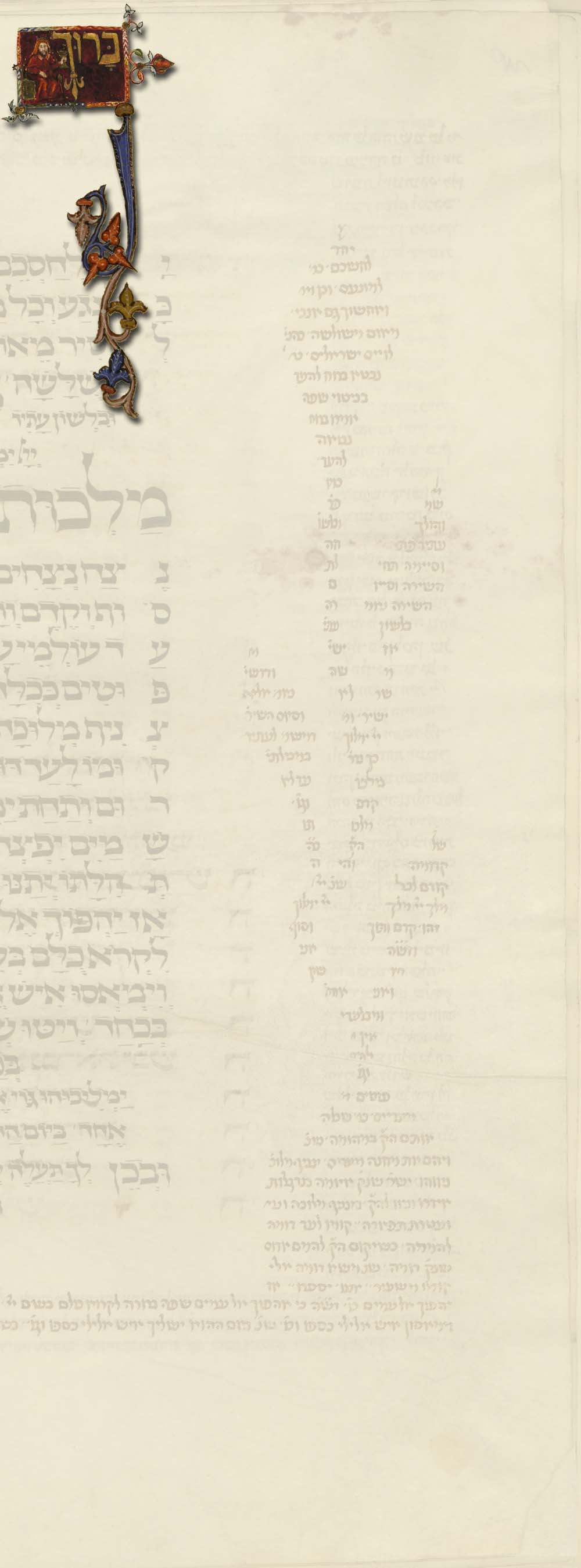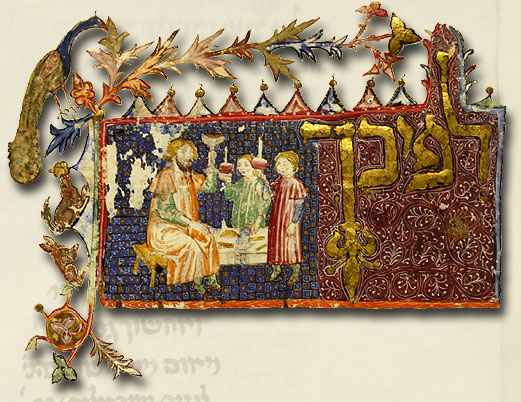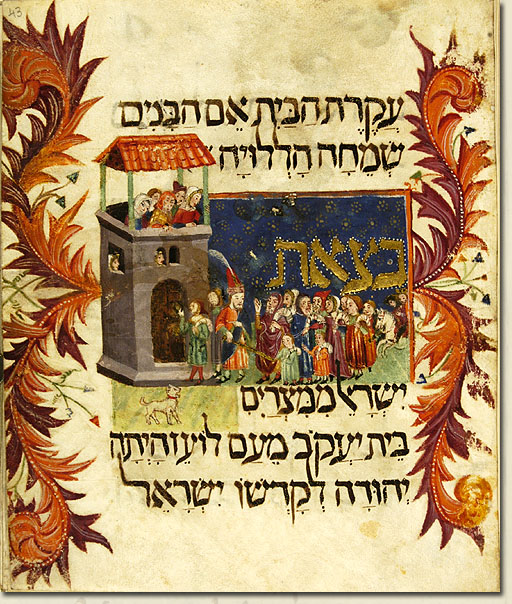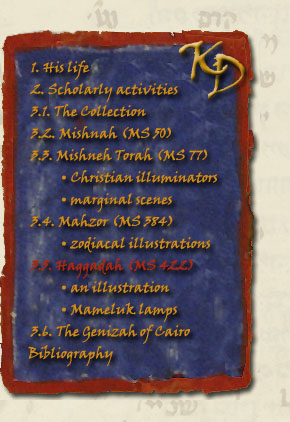




 3.5. Haggadah (MS A 422)
3.5. Haggadah (MS A 422)

Perhaps the most famous manuscript in the whole Kaufmann Collection is the so-called Kaufmann Haggadah (MS Kaufmann A 422). 181 It was produced in 14th century Catalonia. The first scholars to study it considered this manuscript to be of Italian origin. Subsequent research, however, traced its origins to Catalonia. 182 It contains the prayers, poems and narrative texts to be recited on the eve of the festival of the Jewish Easter, Pesach, the Feast of the Passover, 183 in which the participants recall the joy of deliverance from servitude in Egypt, thanking God for his miraculous works. 184 In the 11-15th centuries Haggadahs were not infrequently produced for private, family use – the Kaufmann manuscript also bears the marks of almost excessive use.
Both in the Kaufmann Haggadah and the
Sarajevo Haggadah there are conspicuous traces of children's drawings, a fact no
doubt indicative of the considerable popularity of these manuscripts among
children, which can also be explained, to a certain extent at least, by the
important part children play in the traditional rite of Passover. 185
In view of this there can hardly be imagined a sadder scene than when one of the
sons of the
 family appeared at the Sephardic elementary school in Sarajevo with
one of the family's most treasured possessions, something they had owned perhaps
for a considerable period, forced now to sell it because of straitened
circumstances occasioned by the sudden death of their father: the lavishly
illuminated manuscript became known as the Sarajevo
family appeared at the Sephardic elementary school in Sarajevo with
one of the family's most treasured possessions, something they had owned perhaps
for a considerable period, forced now to sell it because of straitened
circumstances occasioned by the sudden death of their father: the lavishly
illuminated manuscript became known as the Sarajevo
 Haggadah. 186
It may have been in a similar straitened situation that that the
Schwarz family parted with the
splendid, illuminated Mahzor executed in France around 1300, which they had
possessed since 1702 and which was still in their possession in Miskolc,
Hungary, in the 1950s. The family later emigrated to Canada and there they sold
the priceless manuscript. 187
Haggadah. 186
It may have been in a similar straitened situation that that the
Schwarz family parted with the
splendid, illuminated Mahzor executed in France around 1300, which they had
possessed since 1702 and which was still in their possession in Miskolc,
Hungary, in the 1950s. The family later emigrated to Canada and there they sold
the priceless manuscript. 187
We can see in our mind's eye the
father who is all too fond of showing his children the splendid illustrations,
both on the festival itself and at other times too. Young and old alike gather
around him after dinner in order to enjoy the paintings: children play a central
role in the rite of Passover and what else can arouse their interest but
splendid pictures? 188
They are gazing spellbound at the marvellous illustration depicting the Exodus
from Egypt: the bearded Moses in his pointed red hat with a feather is leading
the Jews, who are carrying dough wrapped in cloths over their shoulders (Ex
12:34-35). On the left an Egyptian city lying on their way can be seen (Baal
Zephon? cf. Ex 14:2), its gates closed while from above the inhabitants watch
the Jews passing by and knocking on the gates, while a dog wearing a crimson
neckband is standing in the foreground. The figure of the dog, which seems to
have been treated very well in
![]()
 recent times, is an allusion to the passage: “But
against the children of Israel no dog shall stick out its tongue” (Ex
11:7). 189
The exact meaning of the expression is not quite clear, it seems to mean
something like “to stick the tongue out, to threat someone.” Our illustration
apparently follows the traditional interpretation going back to
Rashi quoted above: the dog's
tongue seems to be missing. 190
In the background the crowned figure of Pharaoh emerges, pursuing the refugees. 191
Young and old are amazed at the marvellous figures that populate the folios of
the manuscript and in this family circle the father is all too willing to yield
to their urging and to tell them the stories of the Biblical figures, while the
imagination of the young is captivated more by the owls – the
latter serves as a decoration for the panel of the son who does not know how to
ask. In the former illustration we can see a figure emerging from the decoration
in the margin aiming with his arrow at an owl. A very similar scene appears in
the 14th century Catalonian Haggadah formerly in the possession of the Earl of
Crawford and Balcarres (London), now one of the treasures of the John Rylands
University Library (Manchester; Hebrew
MS. 6): a fantastic hybrid is
aiming with his arrow at an owl from below. 192 In the case of a hunter aiming
with his arrow at an owl we are in all probability dealing with a simple
decoration in the margin, although there have been efforts to interpret it as
the extension of the motif of the rabbit hunt so common in Ashkenazic Haggadahs,
which owes its popularity to a Jewish German mnemotechnic pun there. Namely, the
initials of the Hebrew names of the ceremonial elements of the twofold
benediction at the beginning of the feast of Passover and at the termination of
Sabbath add up to an expression which lends itself to a Jewish German
interpretation as an acronym: Yayin [wine], Qiddush
[sanctification], Ner [light], Havdalah [distinction], Zeman
[time] >
YaQeNHaZ > Jag'n Has' >
Jag' den Has' = Chase the rabbit! The
acceptance of this interpretation in our case is seriously hindered by the fact
that it only works in a Germanic-speaking context, unless we assume that it was
already a popular motif that found its way from one community to the other. 193
recent times, is an allusion to the passage: “But
against the children of Israel no dog shall stick out its tongue” (Ex
11:7). 189
The exact meaning of the expression is not quite clear, it seems to mean
something like “to stick the tongue out, to threat someone.” Our illustration
apparently follows the traditional interpretation going back to
Rashi quoted above: the dog's
tongue seems to be missing. 190
In the background the crowned figure of Pharaoh emerges, pursuing the refugees. 191
Young and old are amazed at the marvellous figures that populate the folios of
the manuscript and in this family circle the father is all too willing to yield
to their urging and to tell them the stories of the Biblical figures, while the
imagination of the young is captivated more by the owls – the
latter serves as a decoration for the panel of the son who does not know how to
ask. In the former illustration we can see a figure emerging from the decoration
in the margin aiming with his arrow at an owl. A very similar scene appears in
the 14th century Catalonian Haggadah formerly in the possession of the Earl of
Crawford and Balcarres (London), now one of the treasures of the John Rylands
University Library (Manchester; Hebrew
MS. 6): a fantastic hybrid is
aiming with his arrow at an owl from below. 192 In the case of a hunter aiming
with his arrow at an owl we are in all probability dealing with a simple
decoration in the margin, although there have been efforts to interpret it as
the extension of the motif of the rabbit hunt so common in Ashkenazic Haggadahs,
which owes its popularity to a Jewish German mnemotechnic pun there. Namely, the
initials of the Hebrew names of the ceremonial elements of the twofold
benediction at the beginning of the feast of Passover and at the termination of
Sabbath add up to an expression which lends itself to a Jewish German
interpretation as an acronym: Yayin [wine], Qiddush
[sanctification], Ner [light], Havdalah [distinction], Zeman
[time] >
YaQeNHaZ > Jag'n Has' >
Jag' den Has' = Chase the rabbit! The
acceptance of this interpretation in our case is seriously hindered by the fact
that it only works in a Germanic-speaking context, unless we assume that it was
already a popular motif that found its way from one community to the other. 193
In the Rylands Haggadah the motif of the hare-hunt and the hunter aiming with his arrow at an owl appear in fact on the same page (fol. 29v). 194 In Roth's opinion, the hare-hunt may be “no more than a pictorial echo of the widespread European practice of a hare-hunt at this season of the year, at Eastertide: a practice itself doubtless rooted in pagan antiquity. (The hare was in fact the sacred animal of the Teutonic goddess of the spring Eostre or Ostâra, from which derives the name Easter, and in Continental Europe is still as characteristic of the season as the egg, which likewise survives in the Jewish Passover observances).” 195 The hare is of course a well-known symbol of fertility too. Similar decorations are widespread in the margins of Christian manuscripts, too. 196 Staghunting and similar motifs may perhaps allude to the persecution of Jews in Hebrew manuscripts while the hare pursuing the hunter and the dog is a popular motif of the world turned upside down (monde renversé). 197 Incidentally, in Christian manuscripts, owls are frequently used as symbols of the Jews, who – just like the birds of the night – prefer the darkness of error and sin to the light of the Gospel. 198
Young and old are also captivated by the cockfight with the strange semi-nude grotesques riding on them, or the illustration of Pesach: a bareheaded man is leading a lamb on a lead with a knife in his left hand. 199 The fact that the figure of the wicked son is represented by an armed soldier, a mercenary, probably reflects the sad experiences of mediaeval Jewry. 200 On the other hand, the wise son is represented by the beautiful figure of a scholar in a green mantle.
Our manuscript is in rather bad condition. 201 The colours were of inferior quality right at the time of its birth and the manner of its execution also left a lot to be desired. As a consequence of heavy use, the colours and the gold simply fell off in many places. They were subsequently replaced with substances of even lower quality, and this procedure may have been repeated several times in certain parts. The margins of the manuscript are mutilated too: over the centuries the manuscript was rebound, perhaps several times, and on these occasions the margins were trimmed, as a consequence of which the decorations in the margins have been damaged in a number of places. In spite of all this, however, the manuscript is still a most precious relic of cultural history – in addition to its religious significance – and one of the most important gems of mediaeval art in general. The interested reader is referred to the splendid facsimile edition published recently, which is accompanied by a fascicle containing a valuable and informative essay by Gabrielle Sed-Rajna. 202 In addition to the “standard” version, which was also published in English, there appeared a luxury edition in a velvet presentation box accompanied by a considerably longer essay [39 pp.; 30 cm] with the detailed and exact description of the Biblical scenes among others. This is all the more important because owing to the loss of colours and the disturbed sequence of the pictures, even a skilled eye will sometimes fail to recognize the subject of a given picture.
181 It is worth mentioning in
connection with this manuscript that the earlier pagination was
replaced by folio-numbers at its restoration in 1987.
Consequently, earlier references to page-numbers do not coincide with
modern references to folio-numbers.
182
Müller – von Schlosser:
Bilderhaggaden 1898. 189. [=Weisz 1906. 146-147.]
von Schlosser Bilderschmuck
1898. 211. Scheiber 1957. 8-12. Gabrielle
Sed-Rajna: The Kaufmann
Haggadah. Budapest 1990. 6.
183 Cf. “For the
Lord will pass through to
smite the Egyptians; and when he sees the blood upon the lintel,
and on the two side posts, the
Lord
will pass over the door, and will not allow the destroyer to
enter your houses to strike you.” Ex 12:23.
184 On the decoration program of
Catalonian Haggadas in general see
Narkiss 1982. I. 42-44.
185 See the next paragraph.
186
Werber 1988. 20.
187 Fine Judaica including a
highly important Mediaeval
 Illuminated Hebrew Manuscript. Sale:
Wednesday 21 June 1989. Christie's Amsterdam. 1989. 142-149 [No. 390].
Gabrielle Sed-Rajna: Les
manuscrits hébreux enluminés des bibliothčques de France. Notices
codicologiques, relevé des inscriptions par Sonia
Fellous. [Corpus of
Illuminated Manuscripts, Vol. 7. Oriental Series 3.] Leuven – Paris
1994. 172-174 [No. 68].
Illuminated Hebrew Manuscript. Sale:
Wednesday 21 June 1989. Christie's Amsterdam. 1989. 142-149 [No. 390].
Gabrielle Sed-Rajna: Les
manuscrits hébreux enluminés des bibliothčques de France. Notices
codicologiques, relevé des inscriptions par Sonia
Fellous. [Corpus of
Illuminated Manuscripts, Vol. 7. Oriental Series 3.] Leuven – Paris
1994. 172-174 [No. 68].
188
Kohn Zoltán: Magyarázó
jegyzetek a haggádához. [=Explanatory remarks to the Haggadah]. In:
OMZSA haggáda [=Haggadah of the National Hungarian Jewish Rescue Action
/ Országos Magyar Zsidó Segítő Akció]. Budapest 1942. 73 [117, 118].
Munkácsi Ernő: A peszach
ünnep története [=The history of Pesach festival]. In: OMZSA
haggáda 1942. XXXII, XLVIII.
Munkácsi c. 1938. 14.
189
Kaufmann: Bilderzyklen.
In: Kaufmann 1908-1915. III.
233.
190
Gesenius 1959. 262a.
Koehler – Baumgartner 1967-1995.
342. Das zweite Buch Mose. Exodus. 1961. 68 [ad loc.].
On associations with dogs in Jewish and Christian art in general see
Mellinkoff 1999. 38-39.
Réau 1955-1959. I. 128.
191
Müller – von Schlosser:
Bilderhaggaden 1898. 189, 197 [ad p. 74].
Narkiss – Sed-Rajna
1988. Kaufmann Haggadah. Card No. 44.
192
Müller – von Schlosser:
Bilderhaggaden 1898. 102, Plate III.
[Tafel III.]. Roth 1960,
ill. opp. page 137 (fol. 29v), 140-141.
Narkiss 1982. II. 90
[fig. 267].
193
Müller – von Schlosser:
Bilderhaggaden 1898. 133-134. von Schlosser Bilderschmuck
1898. 237. Metzger 1973. 98-103.
194
Roth 1960. ill. opposite
page 137, 140-141.
195 Ibid.
196 Ibid. 347-348.
197
Scheiber 1957. 26-27.
198
Réau 1955-1959. I. 126.
199
Müller – von Schlosser:
Bilderhaggaden 1898. 196 (ad p. 64).
Narkiss
– Sed-Rajna 1988. Kaufmann Haggadah. Card No. 38.
Metzger 1973. 183.
200 Cf. also
Kaufmann: Bilderzyklen.
In: Kaufmann 1908-1915.
III. 237 (ad F. 9a. 35). Scheiber 1957. 26. Metzger 1973. 149-156. Narkiss 1982. 43.
201 Our manuscript was restored
under the guidance of Ildikó Beöthy-Kozocsa in the Restoration Workshop of the National
Széchényi Library, Budapest, in 1987. This meant the conservation of the
given condition and the preservation of the manuscript rather than the
replacement of parts already destroyed or lost.
202 Kaufmann haggáda. A Magyar
Tudományos Akadémia Könyvtára Keleti Gyűjteményében őrzött, 14.
századból származó héber kézirat. Budapest 1990. (Also with a Hebrew
title-page at the other end.) The accompanying essay in a separate
fascicle: Gabrielle Sed-Rajna:
Kaufmann haggáda. Budapest 1990. 23 pp. [27 cm]. Incidentally, an
earlier facsimile edition of this manuscript appeared in 1957: The
Kaufmann Haggadah. Facsimile edition of MS 422 of the Kaufmann
Collection in the Oriental Library of the Hungarian Academy of Sciences.
[Publications of the Oriental Library of the Hungarian Academy of
Sciences, I.] Budapest 1957 (plates). Alexander
Scheiber: The Kaufmann
Haggadah. Budapest 1957 (an informative essay in a separate
fascicle.) It was also published in German in two editions in 1958 and
1959.
